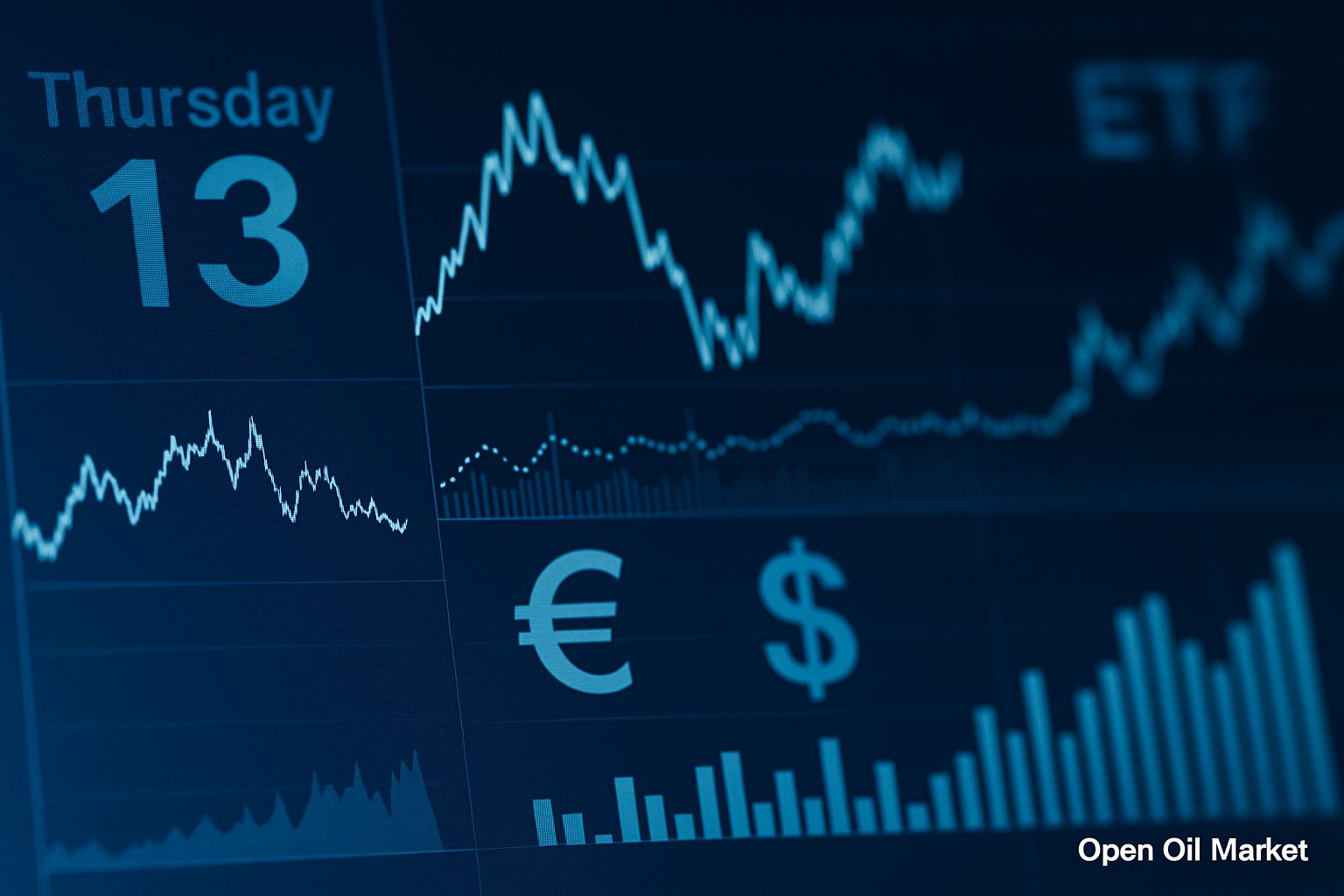
Main Economic Events and Corporate Earnings Reports for Friday, November 14, 2025: China’s Industrial Production Data, Eurozone GDP, EIA Natural Gas Report, and Results from Major US, European, and Asian Companies. Analysis and Predictions for Investors.
Today, Friday, November 14, 2025, investors from the CIS countries are closely monitoring a series of significant events in the global economy and corporate sector. Key macroeconomic indicators from China, the Eurozone, and the US, as well as quarterly results from several large and mid-cap companies, are in the spotlight. These data and reports could impact global markets, stock dynamics, and investment decisions, prompting analysts and market participants to prepare for immediate reactions. Below is an overview of the main events of the day, presented in a business style characterized by elements typical of Bloomberg and Financial Times—from economic statistics to corporate reports—accompanied by context and concise analysis for investors.
Economic Events
05:00 MSK – China: Industrial Production (October)
Early in the morning, data on China’s industrial production for October 2025 will be released. A slight slowdown in growth rates is anticipated, with expectations of around +5.5% year-on-year compared to +6.5% the previous month:contentReference[oaicite:0]{index=0}. This indicates a deceleration in industrial activity amid weakening domestic demand and exports. The report comes in the context of a continuing decline in retail sales and fixed asset investments in China:contentReference[oaicite:1]{index=1}, raising concerns among analysts about the sustainability of the world’s second-largest economy. Investors will closely assess these figures as they influence sentiments in commodity markets (oil, metals) and the stocks of companies linked to the Chinese economy. Any deviation of the actual data from expectations could lead to significant movements in emerging markets and adjust forecasts for economic growth.
13:00 MSK – Eurozone: GDP Q3 2025 (Preliminary Data)
In the afternoon, the preliminary estimate of the Eurozone’s GDP for the third quarter of 2025 will be announced. The economy of the currency bloc is projected to have nearly stagnated, with growth expected at just +0.1–0.2% quarter-on-quarter (after a similar +0.1% in Q2):contentReference[oaicite:2]{index=2}. This corresponds to annual growth rates of about 1.3%, down from 1.5% the previous quarter. Such modest figures confirm the ongoing stagnation in the region amid high interest rates and weak demand:contentReference[oaicite:3]{index=3}. In the Eurozone’s largest economy, Germany, stagnation (0.0% quarter-on-quarter) has been recorded in Q3 against a backdrop of declining exports:contentReference[oaicite:4]{index=4}, highlighting the vulnerability of European growth. GDP data is crucial for investors and analysts as it will signal the state of the Eurozone’s economy and may influence forecasts for future ECB policy. If the actual growth exceeds expectations, it could support the euro and European stock markets; conversely, a weaker result may heighten concerns about recession risks and elicit a negative market reaction.
18:30 MSK – US: Weekly Natural Gas Stocks (EIA)
In the evening, market attention will turn to the weekly report from the US Energy Information Administration (EIA) on natural gas stocks. These data are typically released on Thursdays, but this week's publication has been shifted to Friday. The previous report showed a net injection into storage of +33 billion cubic feet for the week ending October 31, which is below the five-year average of 42 billion for the same period:contentReference[oaicite:5]{index=5}. Total gas stocks in the US reached approximately 3.915 trillion cubic feet—about 4% above the average for the past five years:contentReference[oaicite:6]{index=6}, remaining close to last year’s levels. These figures indicate a comfortable level of stocks at the onset of the winter season, which may temper gas price increases. Market investors and traders will assess whether the seasonal drawdown of gas from storage has commenced; an early start to active withdrawals or an unusually large decrease in stocks could heighten price volatility. Conversely, maintaining high stock levels is favorable for industrial consumers and may ease price pressures, which is important for analysts monitoring energy markets. The EIA's gas report could influence not only US gas futures prices but also indirectly affect the global liquefied gas market, upon which European and Asian consumers rely.
Corporate Earnings Reports
US: Reports from S&P 500 Companies and More
In the US, the quarterly reporting season is nearing its conclusion, with most corporations from the S&P 500 already having published their reports for the third quarter. As of November 14, few new publications are expected from the largest companies, so the focus will shift to the results of mid- and small-cap businesses. Among these are representatives from the biotechnology and pharmaceutical sectors: Scholar Rock (SRRK), Twist Bioscience (TWST), MiNK Therapeutics (INKT), and Iterum Therapeutics (ITRM) will report on their progress in medical developments. Additionally, several technology companies will release reports: for example, cryptocurrency mining firms HIVE Digital (HIVE) and Bit Digital (BTBT) will present results amid volatility in digital asset markets, while the fintech platform Forge Global (FRGE) will share demand metrics in the private equity market. In the financial sector, regional bank SmartBank (SBC) will publish its metrics against a backdrop of changing interest rates. From the commodities sector, the results from lithium producer Sigma Lithium (SGML) will be noteworthy for assessing the market dynamics for battery metals. Collectively, these corporate reports will provide investors and analysts with extensive material for analysis—ranging from revenue dynamics in innovative sectors to cost management effectiveness amid high rates. Strong reports could locally support the stocks of the relevant companies, while weak results might lead to sell-offs in certain stocks.
Europe: Euro Stoxx 50 Companies Wrap Up Reporting Season
In Europe (Eurozone), the corporate earnings season for Q3 is also nearing its end. Overall, the results from the largest European companies have exceeded expectations: recent forecasts indicate an average profit growth of around +6% year-on-year, higher than the previously anticipated ~4%:contentReference[oaicite:7]{index=7}. This positive surprise has bolstered European stock indices, many of which have reached multi-year highs in November. This week, investors are particularly focused on reports from notable firms within the Euro Stoxx 50. For instance, German industrial giant Siemens reported record financial results for the 2025 fiscal year—Q4 revenue grew by 3% (to €21.4 billion):contentReference[oaicite:8]{index=8}, affirming sustained demand for the company's products. The region’s largest insurance company, Allianz, has also reported during these days, showcasing stability in financial results amid a challenging macroeconomic environment. Overall, European firms have managed to overcome many economic uncertainties in recent months, which explains the improved profit outlooks:contentReference[oaicite:9]{index=9}:contentReference[oaicite:10]{index=10}. Analysts note that strong quarterly reports in Europe have become one of the drivers of the stock market rally, while previous concerns about a downturn have partially not materialized. However, investors will continue to keep an eye on corporate news—especially in sectors sensitive to consumer demand and exports—to timely detect any potential deterioration in the situation.
Asia: Reports from Nikkei 225 Companies and Market Dynamics
In the Asia-Pacific region, market participants are focusing on corporate news from Japan and neighboring countries. In Tokyo, companies in the Nikkei 225 index are concluding their financial report publications, and the overall picture is favorable. Many Japanese corporations have demonstrated confident profit growth over the half-year, supported by a weak yen (enhancing export revenue) and high demand for technological goods. A notable example is SoftBank Group, which reported more than a twofold increase in net income for Q2 of its fiscal year (to ¥2.5 trillion):contentReference[oaicite:11]{index=11}. This sharp revenue surge for SoftBank is linked to a reevaluation of investments in the technology sector (including in artificial intelligence) and serves as a positive signal for the entire tech market segment. The Japanese stock index Nikkei 225 is close to multi-year highs, largely propelled by such strong reports and an influx of foreign investor funds. In the rest of Asia, no major corporate publications are scheduled for this Friday, but investors continue to monitor the markets in China and other countries—upcoming quarterly results from large Chinese internet companies and industrial giants could influence regional sentiments. Overall, the Asian corporate landscape remains stable, sustaining global investors' interest in the region's markets.
Russia: Expectations for Reporting and Market Overview
In the Russian market (MOEX index), the release of financial results from companies for the first nine months of 2025 continues. Analysts estimate that most major issuers will publish their IFRS reports by the end of November:contentReference[oaicite:12]{index=12}. Investor interest is concentrated in the oil and gas sector, where outlooks remain optimistic: expectations are for an increase in ruble-denominated oil prices, which will support exporters' revenues, and the overall sentiment towards the sector remains “positive”:contentReference[oaicite:13]{index=13}. In particular, experts from BCS highlight the stocks of Lukoil, Rosneft, and Gazprom Neft as favorites in the Russian oil sector:contentReference[oaicite:14]{index=14}, anticipating strong financial results from them. Additionally, reports from banks, metallurgical, and telecommunications companies are being released, providing a more comprehensive snapshot of the Russian economy. Thus far, the reporting of domestic firms has generally demonstrated business resilience even amid sanctions and ruble volatility—many companies remain profitable and continue to pay dividends. These factors contribute to a partial restoration of investor confidence and support the quotes of Russian stocks. However, market participants are closely evaluating each new release: weak results from individual issuers (if any arise) could lead to localized sell-offs, whereas strong reporting could serve as a driver for growth in the respective stocks.
Conclusions and Recommendations for Investors
A busy day on Friday, November 14, has the potential to set the tone for global markets at the end of the week. The outcomes of the published data and reports will serve as a benchmark for investors' future actions. Macroeconomic statistics will shape overall sentiments: weak data from China could amplify concerns about global economic slowdown and reduce risk appetite, while stronger Chinese statistics could bolster commodity markets and stocks in emerging countries. In the Eurozone, confirmation of minimal GDP growth will serve as a reminder of the region's economic fragility—this fact is largely priced in by the market; however, any surprises (in either direction) could have short-term effects on the euro and European indices. Data on gas stocks in the US is important for energy investors: ongoing oversupply may keep prices from rising sharply, which is beneficial for gas consumers and industry but limits the potential for oil and gas company stocks; however, as winter approaches, the situation may change rapidly with the first signs of accelerated stock drawdowns.
Corporate reports will provide more targeted benchmarks for the equity market. Successful quarterly results, especially in high-tech and commodities sectors, are likely to provoke local rallies in the respective stocks—investors are eager to reward companies whose profit and revenue exceed analysts’ expectations. Conversely, disappointing reports or cautious management forecasts may lead to profit-taking: we have already seen such reactions in some sectors previously. In the Russian market, maintaining robust financial results among key companies (particularly in oil and gas) will be a positive signal confirming business resilience in challenging conditions—this could attract additional demand for undervalued stocks. However, if some major players report worse than expected results, volatility in the local market may increase.
Given the large volume of new information, investors are advised to act judiciously and adhere to diversification principles. The data and reports obtained today should be analyzed in the context of long-term trends rather than prompt hasty emotional conclusions. Experts recommend paying special attention to fundamental indicators: economic growth rates, corporate profit dynamics, companies' debt load, and their future forecasts. If necessary, after reviewing all current analyses, it may be prudent to make precise adjustments to the investment portfolio—for example, reconsidering sector allocations impacted by new information (increasing exposure to more promising sectors and reducing exposure to those where deterioration is emerging). Overall, maintaining asset balance and regularly monitoring news will help CIS investors confidently navigate the current market situation, effectively responding to emerging challenges and opportunities.




